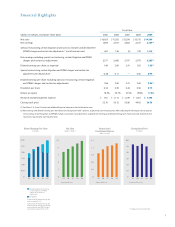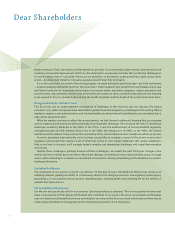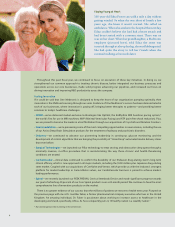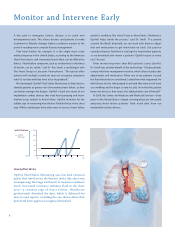Medtronic 2009 Annual Report Download - page 14
Download and view the complete annual report
Please find page 14 of the 2009 Medtronic annual report below. You can navigate through the pages in the report by either clicking on the pages listed below, or by using the keyword search tool below to find specific information within the annual report.
Give Patients Control
“Marianne has been a great
help. When my insulin
pump infusion set wasn’t
sticking to my skin as well
as it was supposed to,
I called her to see what I
should do. She suggested I
let the skin prep dry before
applying the infusion set.
That did the trick.”
Diabetes patient Pinkal Patel
with Medtronic Diabetes Clinical Manager
Marianne McAndrew
Pottsville, Pennsylvania
The more we can give patients control of their own disease
management, the more freedom they gain. One example of how
Medtronic therapies give patients greater independence and
freedom is in our diabetes business.
We continually improve our insulin pumps and continuous
glucose monitoring (CGM) systems to give patients greater
control over their blood glucose levels—which are affected
around the clock by many factors, including diet, exercise and
stress. The ultimate in diabetes control and convenience will be
a closed-loop insulin delivery system that relieves patients of
manual diabetes management. For several years, we’ve had a
four-phase plan in place to create a closed-loop system:
Phase 1: Pumping and Sensing—Our insulin pumps, available
since 1983, are designed to closely mimic the insulin delivery
of a normal pancreas. Our CGM devices, first approved in 1999,
monitor the body’s glucose values in real time, offering increased
visibility to blood sugar fluctuations.
Phase 2: Communicating—In 2006 we introduced the first
and only insulin pump integrated with CGM, which helps patients
make the right insulin changes at the right time. Our CareLink
Therapy Management Software complements these technologies,
serving as a virtual logbook. Patients and their physicians can
download and organize their glucose information into numerous
reports, charts and graphs to see trends over time.
“The faster patients get feedback, the more ownership they
take in managing their condition,” said Marianne McAndrew, a
Medtronic diabetes clinical manager who’s been educating
patients for 25 years. “I had one patient who said that seeing the
trends in his blood sugars after eating desserts helped him make
better food choices.”
The clinical benefits of CGM are proven. A landmark study
funded by the Juvenile Diabetes Research Foundation showed
that CGM helped adult patients with type 1 diabetes significantly
lower their blood glucose. In fact, all patients, regardless of their
age, improved their glucose control when using CGM at least six
days a week. Insurance coverage is also improving for CGM. In the
United States—Medtronic’s largest diabetes market—more than
90 percent of type 1 diabetes patients with commercial insurance
now have access to CGM if they meet health plan criteria.
Phase 3: Acting—In June 2009, we introduced our first semi-
closed-loop system in the United Kingdom. It is a CGM-integrated
insulin pump that automatically suspends insulin delivery
temporarily if a patient’s glucose levels become too low. While
not yet approved in the United States, this major step toward a
closed-loop system protects against the risk of low blood sugar,
even when the person is asleep or unable to react.
Phase 4: Automating—We are working on the sophisticated
sensor algorithms needed to adjust insulin delivery automatically
in response to CGM data.
10
























